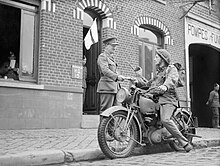Ivy Farm (Knockholt)


Ivy Farm (German literally: " Ivy - Farm ") is a farm in the English community Knockholt about 25 km south-east of Central London . It is located in the district of The Pound not far from the pub The Three Horseshoes ("The Three Horseshoes") on Knockholter Main Road .
The Ivy Farm had a very special meaning during World War II . Here was an important namely radio listening station ( Y station ) of the British Government Code and Cypher School (GC & CS) ( German about "Government Code and Cipher School"), known as Government Communications Wireless Station ( GCWS ) . She specialized in the encrypted secret German radio telex , which the British had given the code name Fish . The Ivy Farm was thus an outstation of Bletchley Park (BP) . The radio teletype messages of the German Wehrmacht were received here, recorded using undulator tapes (picture) and then transcribed on punched tape . A distinction was made between three important work steps, namely interception (radio interception and recording), slip reading (reading of the undulator strips) and reperforation (punching the punched tape ).
The GCWS in Knockholt started its work in June 1942 after the Ivy Farm had been requisitioned the previous month . In addition to the farm building itself, around 650,000 m² of land (160 acres ) were available for antenna systems and barracks . The head was Harold Charles Kenworthy (1892–1987), who, in addition to the GCWS Knockholt, also had an attached laboratory and workshop called the Foreign Office Research and Development Establishment (FORDE) . The number of employees rose rapidly from just six in June 1942 to 120 a year later and 600 in June 1944 to 815 at the end of the war in Europe .
The ciphertexts captured mainly with the help of shortwave receivers of the brands National HRO and AR-88 (see also: web links ) went via two different routes to station X in Bletchley. On the one hand, it was sent in parallel from Knockholt to Bletchley with the help of a British teleprinter over two different lines of the British GPO network ( General Post Office ) and received there by two different teleprinters. After checking for identity, they were only used if they were the same or contained at most five errors, otherwise the transmission had to be repeated. On the other hand, the original punched tape and the undulator tape were driven by dispatch rider ( motorcycle detector ) over the slightly more than 100 km long route to Bletchley.
There, the British Codebreakers succeeded in deciphering and evaluating the intelligence service . Up to 400,000 letters of plain text were determined per day. The German secret telexes often contained strategic information of importance to the war effort, which the British grouped under the code name Ultra and used for their own planning.
literature
- James A. Reeds, Whitfield Diffie , JV Field: Breaking Teleprinter Ciphers at Bletchley Park: An edition of IJ Good , D. Michie and G. Timms: General Report on Tunny with Emphasis on Statistical Methods (1945). Wiley - IEEE Press, 2015. ISBN 978-0-470-46589-9 .
Web links
- Ivy Farm House The Ivy Farm building . Photo and explanations (English). Retrieved January 25, 2017.
- GCWS Ivy Farm, Knockholt Pound report on the Government Communications Wireless Station (GCWS) of Ivy Farm (English). Retrieved January 25, 2017.
- Ivy Farm telecom mast Modern radio mast at Ivy Farm . Photo and explanations (English). Retrieved January 25, 2017.
- The HRO shortwave receiver in the Crypto Museum (English). Retrieved January 26, 2017.
- The American AR-88 shortwave receiver from RCA in the Crypto Museum (English). Retrieved January 26, 2017.
- Photo of a radio listening position with American AR-88 shortwave receivers (recreated scene in the British National Computer Museum ). Retrieved January 26, 2017.
Individual evidence
- ↑ James A. Reeds, Whitfield Diffie, JV Field: Breaking Teleprinter Ciphers at Bletchley Park: An edition of I. J. Good, D. Michie and G. Timms: General Report on Tunny with Emphasis on Statistical Methods (1945). Wiley-IEEE Press, 2015, p. 268 (English). ISBN 978-0-470-46589-9 .
- ↑ James A. Reeds, Whitfield Diffie, JV Field: Breaking Teleprinter Ciphers at Bletchley Park: An edition of I. J. Good, D. Michie and G. Timms: General Report on Tunny with Emphasis on Statistical Methods (1945). Wiley-IEEE Press, 2015, pp. 513-529 (English). ISBN 978-0-470-46589-9 .
Coordinates: 51 ° 18 ′ 52.5 ″ N , 0 ° 7 ′ 11 ″ E


